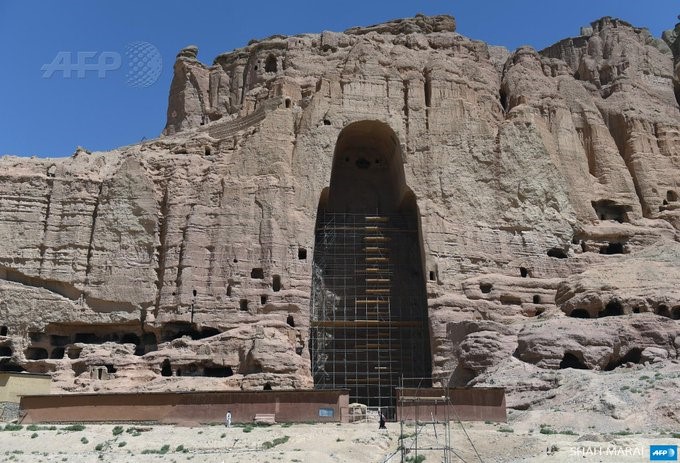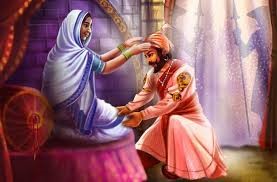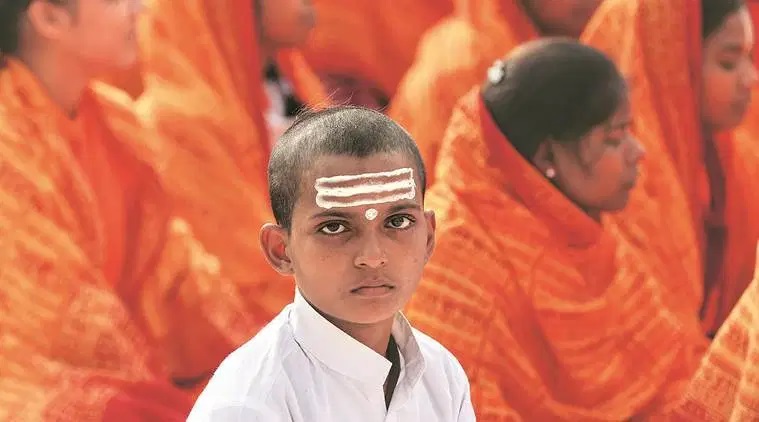Since historic times, being known to be intolerant of adharma was a mark of the greatest honor among the Hindus. In the Bhagavad Gita, Sri Krishna declares the reason for his manifestation on this Earth: to destroy adharma.
“yadā yadā hi dharmasya glānir
bhavati bhārata
abhyutthānam adharmasya tadātmānaṁ sṛijāmyaham || 4-7 ||
Whenever there is a decline in dharma and an increase in adharma, O Arjuna, at that time I manifest myself on earth.
paritrāṇāya sādhūnāṁ vināśhāya
cha duṣhkṛitām
dharma-sansthāpanārthāya sambhavāmi yuge yuge || 4-8 ||
To protect the righteous, to annihilate the wicked, and to reestablish the principles of dharma I appear on this earth, age after age.”
Note that Sri Krishna unambiguously says he means to destroy adharma and does not mention any weak-kneed notion of peace or tolerance. Nassim Taleb, in his book, Skin In The Game, outlines the reasons why in most societies, a small intolerant minority can have a significant impact. Because such a minority with skin in the game persistently puts forth a set of demands, their demands always get met because the larger majority population mostly are unaware or do not care enough to oppose such demands.
“The Kosher population represents less than three tenth of a percent of the residents of the United States. Yet, it appears that almost all drinks are Kosher. Why? Simply because going full Kosher allows the producer, grocer, restaurant, to not have to distinguish between Kosher and nonkosher for liquids, with special markers, separate aisles, separate inventories, different stocking sub-facilities. And the simple rule that changes the total is as follows:
A Kosher (or halal) eater will never eat nonkosher (or nonhalal) food, but a nonkosher eater isn’t banned from eating kosher.”
In the modern Republic of India, intolerant, organised minorities have long been given privileged status. Former Prime Minister, Manmohan Singh, proclaimed that the Muslim minority had the first right to India’s resources! Over the last 70 odd years, the tolerant Hindu majority have been reduced to second-class citizens even as so-called secular politicians try to divide the Hindus on caste and community lines for the sake of votes at every given chance.
The British colonial two-nation plan originally planned to have a Muslim Pakistan and a Hindu India. However, weak-willed leaders such as Gandhi and Nehru rejected the idea of a Hindu India and instead opted for a “secular” India where no religion is supposedly given priority. This sounded good in theory. But, over the past 70 years after independence, Hindus have largely been given the back seat as intolerant, organised minorities have amassed major governmental benefits.
Today, Hindus in India do not have the right to manage their own temples, run their own educational institutes etc. Hindu law was reformed by the government in 1950. For some strange reason, the laws for other religions were never subjected to reform. So, the Muslims and Christians of India are today largely free to practice their religion as they wish. They have the full right and privilege to persecute and harass Hindus at every given chance with violence and conversion. The Hindu majority has, for over 70 years, silently tolerated this harsh treatment.
Communism, Christianity, and Islam impose a monoculture
The Indian leftist intellectual class, along with the Mullahs and Padres, ceaselessly proclaim themselves to be the champions of freedom, diversity, and inclusion. However, their track record all over the world speaks another story. Historically, Islamists have been notorious for being iconoclasts and persecutors of infidels. They have destroyed thousands of years of priceless historical treasures in many countries including India. Following the Babri Masjid demolition of 1991, most of the Pakistani Hindu temples have been destroyed[1] or repurposed for other uses by the Islamic government. The destruction of the Bamiyan Buddhas are another prime example of the inherent intolerance of Islam.

Christians also have had a history of brutal violence and intolerance beginning from their earliest days. This early history has been coming out prominently of late.[2] In more recent times, Christianity has wiped out the indigenous pagan cultures in many places including North East India, Africa, the Pacific Islands etc.
Along similar lines, the Communist dictatorships of China, USSR, and other places succeeded in wiping out much of their own local culture and history.[3] Indian leftists have committed their fair share of destruction both with the spreading of the intellectual contagion of Hindu-hatred and with terrorist violence in the form of Naxalism.
In contrast to these destructive ideologies, Bharat has always followed a policy of pragmatic Hindu-inspired pluralism, which sought to preserve and protect all worthy human creations: noble ideas as well as physical treasures. The varnashrama dharma and jati systems ensured that a diversity of traditions was always well-preserved in Hindu society. Since many centuries, Bharat has played host to minorities such as the Parsis and the Jews, who have blended well with Indian society. Thanks to the influence of the Hindu dharma, India is among the few countries where the Jews were never subject to historical persecution.
Historical Hindu intolerance
Today, liberals and leftist authoritarians routinely condemn the practice of Hinduism. They regularly try to condemn the display of Hindu symbols, for example, that of Hanuman[4]. In 2015, the self-proclaimed intellectual elites of urban India began the drama of returning their awards[5], when no one questioned why they were awarded in the first place. The reason for this drama was the perceived “intolerance” of the Hindu majority. However, it must be clarified that, historically, Hindus have never shied away from intolerance.
The Sanskrit word for tolerance is sahana or sahishnuta. In examining the writings of both early modern and ancient Indians, this quality of sahishnuta was never portrayed as a major virtue. It is only with the state-led imposition of the Nehru-Gandhi brand of false ahimsa[6] (nonviolence) that this tolerance has become an unquestioned dogma among Hindus. It may also be noted that this is not the first time that a sense of false ahimsa has led the Hindu nation astray. In around 250 B.C.E., when King Ashoka converted himself into a zealous Buddhist, he de-emphasised the military of the Maurya Empire. Within the timespan of a hundred or so years, the Greek Yavanas, who were originally defeated by Chandragupta Maurya, the founder of the Maurya Empire, were able to again make inroads into India. It was only thanks to the “intolerance” shown by Pushyamitra Shunga, who established himself as the new emperor, that the foreign invaders were repelled, and the Vedic rule reestablished.

As can be seen from history, it is always an intolerant minority who wins. In around 1637 C.E., Shivaji’s mother, Jijabai, instilled in him a sense of dharma and pride. Thanks to his mother’s influence, Shivaji was able to begin the decline and defeat of the evil empire of Aurangazeb. Shivaji established a new age of justice and dharma in the form of the Hindavi Swarajya (Hindu Self-Rule). He accomplished this with a relatively small minority of soldiers and commanders who stood for dharma.
Following the example set by Shivaji, Hindus need to learn from their own history that an “intolerant” minority, such as the Maratha army of dharmic warriors, can have an immensely positive and wholesome impact on the world. Even in the Bhagavad Gita, Krishna advised Arjuna to be intolerant to those who oppose dharma. Instead of needlessly worrying, Hindus should wear the label of intolerance with pride. Being intolerant towards those who carry out injustice and adharma in the world is a required duty of every soldier of dharma.
Conclusion
The Nehru-Gandhi brand of false ahimsa ensured that Hindus became accustomed to the daily routine of adharma which has resulted from the injustices of Nehruvian state socialism. This state socialism has sapped the general Indian public of prosperity for over 70 years, while corrupt politicians and bureaucrats have hoarded all the wealth. Most Indians continue to suffer thanks to the misguided socialist policies of the secular state.
In 1991, when Prime Minister PV Narasimha Rao had enough of the economic injustice, India saw a significant turnaround and Hindus were able to finally reembrace the righteous pursuit of artha (wealth), the third of the four purusharthas (goals of human life). Until 1991, Hindus in Nehruvian India only had the de facto freedom to pursue just two of the purusharthas: kama (physical desire) and moksha (spiritual liberation).
However, following the Narasimha Rao economic liberalisation, the most important purushartha, namely, dharma, has yet to be reestablished in Indian society. This is evident from the continuing level of pain and suffering ordinary citizens are put through thanks to corrupt government officials. Also, the ancient decentralised establishment of the gram panchayat has been sidelined and a corrupt, uber-centralised bureaucracy and judiciary has been given the power over the life and death of ordinary citizens.[7]
The corruption seen in daily life in India is something that should never have been tolerated. The same goes for the injustice meted out to Hindus by the secular state which treats them as second-class citizens while simultaneously damaging the ecosystem and impoverishing the weakest sections of society. The day when Hindus become truly intolerant of this casual adharma is when India will have a real Hindu renaissance. To reestablish dharma, an intransigent minority of Hindus with skin in the game will have to put forth the dharmic demands to the powers-that-be. To slightly paraphrase Swami Vivekananda:
“An intransigent and intolerant minority of physically well-trained, well-rooted, organised men and women can do more in a year than a mob in a century.”
[1] “Razed temple highlights Pakistan Hindu woes”
[2] “How Christians Destroyed the Ancient World”
[3] Dikötter, Frank.(2016). The Cultural Revolution: A People’s History, 1962—1976
[4] “Rudra Hanuman and Swastika : How Hinduphobia went global”
[5] “‘Award Wapsi’: A Politically Motivated Campaign Organised By Marxists”
[6] Any unconditional ahimsa is patently false. Some Hindu scriptures classify violence for the sake of self-defense and to protect dharma also as ahimsa. This classification is not accepted by the Nehru-Gandhi school of nonviolence.
[7] Balakrishna, Sandeep.(2019). “The Genius of Sanatana Polity and Statecraft: Decolonising Indian Governance”
Featured Image: Indian Express

